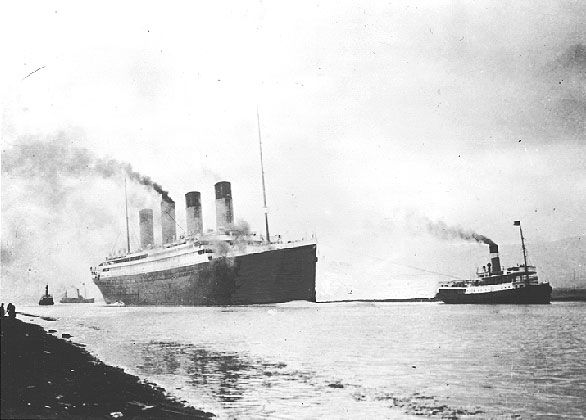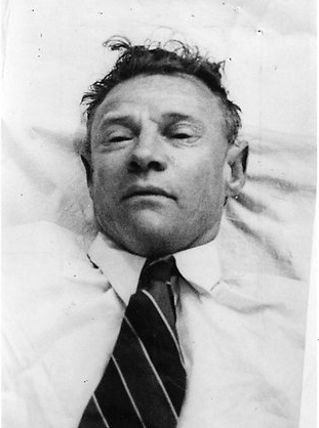Did the Titanic really sink?
- Paige Phillips
- Jan 24, 2019
- 7 min read
The Titanic was the largest ship in the world when it set sail to New York in April of 1912. It set sail from Southampton, carrying more than 2,000 people on board. The luxury liner received warnings of potentially dangerous conditions in the North Atlantic, as large masses of floating ice were rather south than was usual, but continued with its maiden voyage. It was less than 640km away from New York when the radio warnings were received. Lookouts saw the iceberg from 500m away and alerted the bridge. First officer Murdoch took evasive action, steering the ship to port and ordering the engines to stop and ‘full astern’. The warnings came too late, and as the ship veered, the iceberg slid along it’s starboard (right) side, breaching 5 of its watertight compartments. Designer of the titanic, Thomas Andrews, knew his ship could not float for long, and that the lifeboats on board weren’t of high enough capacity to suffice the many passengers on board. The ship sank in just over 2 hours and over 1,500 people died, with Andrews and the ship’s captain, Andrew Smith, among them.
In 1985, Robert Ballard discovered the wreck of the titanic and noted its condition. Most significantly, he confirmed that it had split in two, and that the stern was in far worse shape than the bow. He originally planned to keep the exact location a secret to prevent anyone from claiming prizes for it, and considered the cite a cemetery; refusing to desecrate it by removing artefacts.
Olympic Exchange Theory:
This theory is one of the more controversial and complex ones surrounding the mystery of the titanic, and was originally put forward by Robin Gardiner. He claimed that the ship that sank was actually the Titanic’s sister ship, Olympic, disguised as the titanic as an insurance scam by the ship’s owners, the International Mercantile Marine Group, controlled by J.P. Morgan, that had acquired the White Star line in 1902.
The Olympic was slightly older than the Titanic, and was launched in 1910, despite being built alongside its sister ship. The exterior profile was almost identical to the Titanic, with the only detail that differed was the number of portholes on the forward C decks on the ships, the spacing of the windows on the B decks, and the forward section of the A deck promenade on Titanic that had been enclosed only a few weeks before she set sail to New York. Both ships were built with linoleum floors, but just before the Titanic set sail, the managing director of White Star Line, J. Bruce Ismay, ordered the floors to be carpeted over, failing to give an explanation as to why.

On September 20th 1911, the Olympic was involved in a collision with the Royal Navy Warship, HMS Hawke, in the Southampton Water, whilst under the command of a harbour pilot. The two ships were close enough to each other that the Olympic’s motion drew the Hawke into her aft starboard (right) side, causing extensive damage to the liner, both above and below its waterline. This was due to the fact the HMS Hawke was fitted with a re-inforced ‘ram’ below the waterline, which was purposely designed to cause maximum damage to enemy ships. An inquiry into the crash blamed the Olympic for the incident, despite numerous eyewitness accounts to the contrary. Because of this, White Star’s insurers, Lloyd’s of London, refused to pay out on the claim. The damage also left the ship with permanent damage to the central turbine’s mounting and bent the keel, giving the ship a slight list to port (the vessel was tilted more towards the left). White Star’s flagship (a vessel used to guide a group of naval ships) would also be out of action during the extensive repairs to the Olympic, and the Titanic’s completion date would have to be delayed. The Titanic was already behind schedule on production due to the Olympic’s return to yard after her loss of a propeller blade. All of these issues would amount to a large financial loss for the company. In order to prevent this from happening, and ensure at least one vessel would be earning money, the badly damaged Olympic was patched up and then converted to become the Titanic. The real Titanic would then enter service as the Olympic when its production was complete.
When the titanic left Southampton in April, it did have a slight list to port. The crew working on the titanic demonstrated a lack of proficiency on several occasions, and inadequate trimming of cargo and bunkers could have led to the list to port. This issue was documented by several of Titanic survivors, including Lawrence Beesley, who wrote in his book “The Loss of The SS Titanic: Its Story and Its Lessons, by One of the Survivors” which was released in June of 1912, “I then called the attention of our table to the way the Titanic listed to port (I had noticed this before) and we watched the skyline through the portholes as we sat at the purser’s table in the saloon”. Another survivor, Norman Chambers, also testified after the collision that “There was then a slight list to starboard, and as the ship had a list to port nearly all afternoon, I decided to remain up”.

All other White Star Line ships had their name engraved into the hull, whilst the Titanic alone had its name riveted over the top. Very few parts of either of the Olympic or Titanic bore their name, other than easily removed objects such as the lifeboats, bell compass binnacle and name plates. Everything else on board was White Star issue and could easily be interchanged between the two ships, and other White Star vessels in the fleet.

The alleged plan was to dispose of the Olympic, which had been damaged beyond economic repair, in a way that would allow White Star to collect the full insured value of a brand-new ship. It was alleged that the seacocks (a valve on the ship that allowed water to flow in) would be opened at sea to slowly flood the ship. If numerous ships were stationed nearby to take off the passengers, the shortage of lifeboats would not matter as the ship would slowly sink and the boats could make several trips to the rescuers.
The sea trials for the Olympic in 1910 took two days, and included several high-speed runs. However, the Titanic’s trials reportedly only lasted for one day, and was not working over half-speed. The reason for this would be due to the patched-up hull not being able to take long periods of high speed.
First Officer Murdoch was on the bridge on the 14th April 1912, despite not officially being on duty yet. It was alleged he was positioned there as he was one of the few high-ranking officers, other than Captain Smith, who knew of the plan and was keeping a watch out for the rescue ships. The actual Titanic is alleged to have spent 25 years in service as the Olympic before it was scrapped in 1935.
It wasn’t an iceberg:
Gardiner went on to further hypothesise that the Titanic was not hit by an iceberg, but instead by an IMM rescue ship that was drifting on station with its lights out. The iceberg was seen at such a short distance by the lookouts, which could be explained if an IMM vessel hit the ship, as it would’ve been so dark it would’ve been almost impossible to see. Gardener also states that it would be almost impossible for an iceberg to inflict sustained and serious damage to a steel double-hulled vessel, which the Titanic was. The Californian (the closest ship to the Titanic at the time) has also been criticized for years for its inaction of helping the distressed Titanic. However, it is believed that the SS California saw the IMM rescue ship firing distress rockets, and as it was another IMM ship itself, was not expecting rockets but a rendezvous. The ice on the deck of the Titanic is explained by Gardiner as ice from the rigging of both the Titanic and the mystery ship she hit.
J.P. Morgan cancelled his trip:
J.P. Morgan was amongst a variety of people who cancelled their trip at the last minute reportedly due to ‘business’ that had kept him in France. J. Bruce Ismay’s wife, Julia and their children also cancelled their trip on the Titanic last minute due ill health, but were spotted on a monitoring holiday in Wales the day before.

Seven valuable bronze statues were also ordered to be removed by J.P. Morgan 1 hour before the ship left Southampton. Some people argue this proves he knew the ship was planned to sink.
Portholes:
There are a few disparities in the number of portholes on the ships. The Olympic had 16 and the Titanic had 14. Photographs of the Titanic in dry dock show it was 14 portholes, but by the time it set sail, it had 16, just like the Olympic.

The Olympic also had somewhat unevenly spaced, but more evenly spaced windows than the Titanic. By the time of its maiden voyage, the Titanic had acquired unevenly spaced windows like the Olympic.


Alternative theories:
It was purposely sunk to form the federal reserve
Other theories state that the Titanic was sunk on purpose to eliminate opposition to the federal reserve bank – banks that are jointly responsible for implementing the monetary policy set forth by the Federal Open Market Committee. Some of the wealthiest men in the world at the time were set aboard the Titanic for its maiden voyage, several of whom, including John Jacob Astor IV, Benjamin Guggenheim and Isidor Straus were allegedly opposed to the creation of a U.S. central bank. All three of these men died during the sinking. Some theoriests suggest that J.P. Morgan, the 74 year old financier who set up the investment banking firm that still bears his name, arranged to have the men board the ship and sink it to purposefully eliminate them. Morgan did have a hand in the creation of the Federal Reserve, and owned the International Merciline Line, which owned the White Star Line, and thus the Titanic.
Was it foreshadowed?
“The Wreck of the Titan or Futility” is a 1898 novella written by Morgan Robertson. The book tells the story of an ocean liner called Titan, which sinks in the North Atlantic Ocean after hitting an iceberg.
In the book, the Titan is also described as “unsinkable” and “among the greatest works of men”. Both ships were also hit on their starboard around midnight, and both sank exactly 400 nautical miles from Newfoundland. Both also had a severe lack of lifeboats, as the Titan only held 24, whilst the Titanic had even fewer with 20.
A few other interesting pages on this conspiracy:







Comments